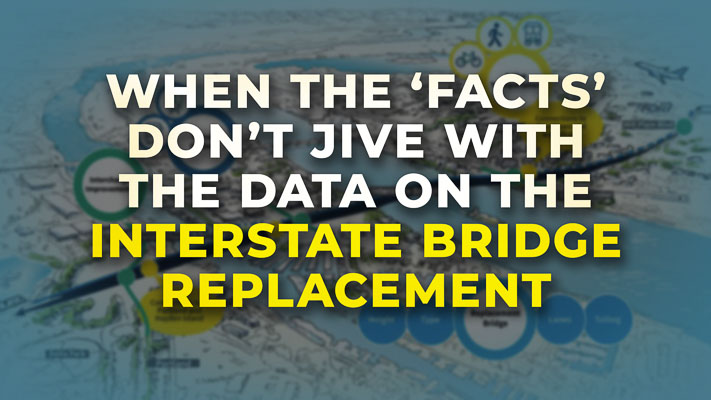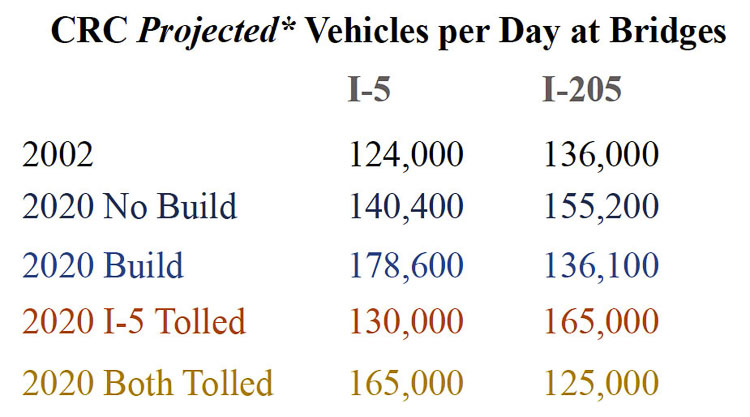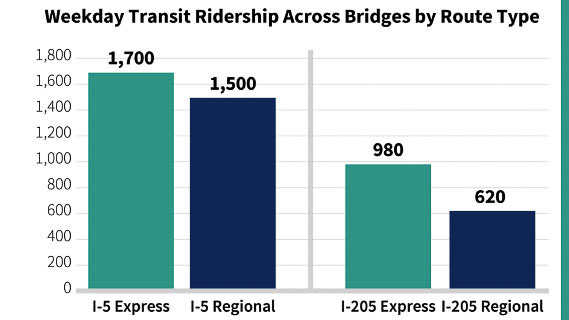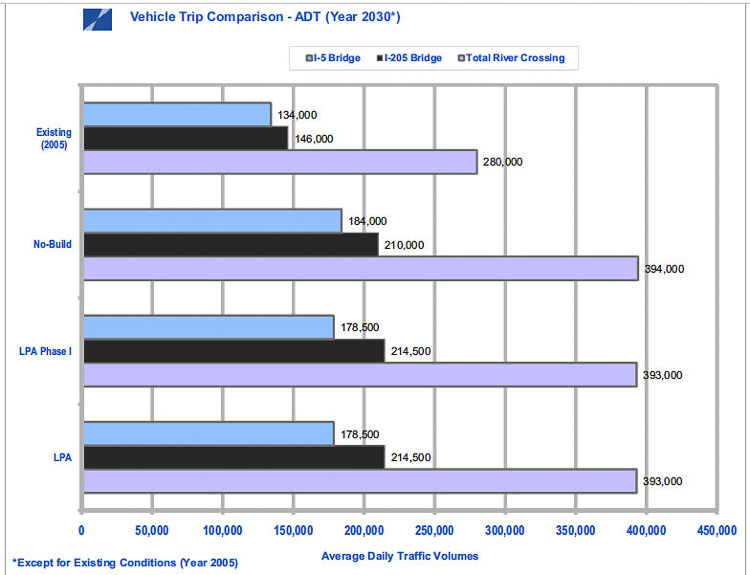
Former Metro councilor reveals more facts showing current effort may be a repeat of failed CRC
A former Metro councilor and senior counsel to Oregon’s Congressman Earl Blumenauer is speaking out against the Interstate Bridge Replacement (IBR) program, saying it is a resurrection of the failed Columbia River Crossing (CRC). Robert Liberty had a front row seat to the CRC’s data and process. He believes the current $5 billion project is not the best use of taxpayer money.
In one news report, the CRC effort was given the moniker “a bridge too false.” A cartoon Pinnochio was used to depict the overall feeling that the consultants and “experts” over the years had not been candid in telling the entire story. The CRC was said to be “a bridge too low,” and “a light rail project in search of a bridge.” But, by most assessments, it did not solve traffic congestion problems, the top issue citizens wanted solved.
The Interstate Bridge Replacement (IBR) team has promised to be “data driven” in proposing a replacement Interstate Bridge. Governors Jay Inslee and Kate Brown promised the project would be data driven when they signed a Memorandum of Understanding over two years ago.
Overwhelmingly, citizens want to save time during their driving trips, and to reduce traffic congestion. Neither of those appear to be resolved by the current project about to be proposed. IBR Administrator Greg Johnson has admitted there will be no significant time savings in response to a very specific question by Oregon Sen. Lew Frederick.
A final proposed solution will be revealed on April 21 by the IBR team. Numerous discussions and details have narrowed down the options, pointing to what they might propose. Yet somehow, many facts don’t seem to agree with the “data” being used by the IBR program.

The IBR staff has informed the Bi-state Bridge Committee of 16 legislators there was “substantial demand” for the high capacity transit they say must be part of the coming proposed solution. They have said tolling must be part of the financial plan to build a bridge. They can only build a bridge with three through lanes because there are only three through lanes north and south of the bridge.
The IBR team was asked to provide the data to back up their assertion there is substantial demand for transit. They declined. Josh Kulla, a member of the IBR communications team, provided the following statement.
“In response to your query about transit ridership figures, we can only say that as the program works toward a transit mode recommendation anticipated to be shared at the end of next month, additional details around transit will be shared at upcoming public meetings. In the interim, you may submit a Public Disclosure Request (PDR) to either WSDOT or ODOT for the specific information you are seeking.”
Clark County Today reached out to the Southwest Washington Regional Transportation Council (RTC), which is working with Metro to provide the data to the IBR team. Director Matt Ransom made an earnest effort before providing the following response.
“Here’s the situation. The YR 2045 future year forecast and model development is a project specific forecast requested by the IBR Program. In consultation with federal lead agency partners, it was determined that YR 2045 is the appropriate future year for updating the CRC project EIS traffic projections, and will serve as the foundation for the IBR technical studies.
“RTC has been involved in fulfilling the IBR travel model development request in combination with Metro’s travel demand model team. RTC and Metro utilize the same regional travel demand model, coordinating extensively in its development, inputs and application. In regards to your request, RTC can’t fulfill it, because we don’t possess the entire results (emphasis added), (meaning, we do not possess all the post-processing refinement the IBR technicians may have completed in refining the RTC/Metro travel demand model forecast, with industry best practices and methods.). Given the sheer number of scenarios evaluated, until the narrowed set of alternatives are established (e.g. No-build scenario, Build scenarios) the refinement process may be ongoing and subject to change – and the validated numbers to your question are pending.
“For the upcoming IBR Supplemental EIS reports, there will be final data tables which should address your questions. In the meantime, the IBR may be able to summarize their work to date, and I would suggest you make this same inquiry of that project.’’
Sen. Lynda Wilson (Republican, 17th District) asked last week “What does substantial demand look like?” she asked. “What does that mean?” She noted that mass transit is currently being underutilized.
Last November, IBR officials told the Bi-state Bridge Committee there were 184,770 person trips traveling across the Interstate Bridge on an average weekday. “The Interstate Bridge primarily serves general purpose traffic,” they said. Transit ridership was 3,200 person trips, equating to 1.7 percent.

A separate graphic showed transit ridership across both Columbia River bridges; 1,600 using I-205 and 3,200 using I-5. There were 1,700 person trips on the “express” bus services C-TRAN offers and 1,500 people on “I-5 regional” service. Note that one person will normally make two trips a day making a round trip to and from work or their destination.
Is 1,600 people making one round trip daily on transit using the I-5 corridor worth a $850 million light rail investment? What is the most cost effective way to serve 1,600 people, or even 3,000 or 4,000 people with transit? C-TRAN’s Vine bus rapid transit (BRT) service carries similar numbers of passengers for a $50 million investment of taxpayer money.
Recent analysis on transit costs showed C-TRAN’s operating costs for its BRT system are 34 percent cheaper than the operating costs (per boarding rider) for the MAX light rail. TriMet’s MAX costs are $8.24 versus C-TRAN’s $5.44 BRT cost per boarding passenger.
The Vine BRT service had 1.4 million boardings in 2019. The Vine lost 44 percent of its ridership during the pandemic, declining to 816,000 boardings last year.
C-TRAN officials originally told the Federal Transit Administration in 2011 they would be carrying 5,000 to 6,000 boarding passengers daily on The Vine. Instead, they carried just under 4,000 prior to the pandemic and were down to 3,000 recently. The decline to 1,700 people using “express” bus service to Portland (both bridges) recently caused C-TRAN to make permanent cuts to its cross river express bus service.
During the most recent meeting of legislators, Sen. Ann Rivers (Republican, 18th District) called for more realistic transit ridership numbers. “When it comes to transit, there is maybe an inordinate optimism that exists,” Rivers said. “I hope that as we move on, we can get something that looks a little bit closer to reality.”
Rep. Jake Fey (Democrat, 27th District) said, “this is a hard time to predict the future,” regarding transit. He noted that people’s travel habits have changed, especially regarding work. “Will we be continually evaluating whether this has permanently changed people’s habits or needs related to travel for work,” he asked.
Robert Liberty
Robert Liberty is a former two-term councilor at Metro regional government. He served as senior counsel to Congressman Earl Blumenauer, and also served as executive director for 1000 Friends of Oregon in the past. He had a front row seat to the CRC.
In a January radio interview, Liberty stated the current effort is deceptive and a revival of the old CRC. (Listen to the full KBOO interview here in The CRC Roars Back to Life.)
“The new name, the Interstate Bridge Replacement Project is a sign of how deceptive the whole effort is because it is based directly on the Columbia River Crossing, both in a legal and technical sense,” he said. “But that has been confirmed by the project staff who are a set of consultants and staff from the two departments of transportation, they’ve described it as tweaking the old project, a revival of the old project.”
“People who are participating in this process are not even clear who makes this decision, who has final authority,” he said. “I think this is also part of the strategy to keep things vague and confused; decision points unclear.”
Former Metro Councilor Robert Liberty is interviewed on KBOO radio in January, sharing his experiences and observations as an insider on the Columbia River Crossing project. He believes the IBR is simply a more expensive version of the CRC and opposed it.
Liberty noted that most of the criticism of the CRC came from the project’s own study documents, which few people actually read.
In November, Liberty shared “nine simple points about the Interstate Bridge Replacement program” with the community. He noted “the IBRP is relying on a modified version of the same “purpose and need statement” and the same NEPA Record of Decision as the Columbia River Crossing project. The project staff has publicly confirmed that the IBRP is a revival of the CRC.”
He highlighted the actual cost of removing the existing structures and replacing them with a new bridge would cost $990 million, in the previous CRC data. There was $1 billion for new Oregon freeway interchanges, $770 million for Washington freeway interchanges, and $850 million for light rail. His data aligned closely with forensic accountant Tiffany Couch’s numbers, showing the bridge cost $792 million.
Liberty cited a 2005 preliminary tolling analysis presented to the Washington Transportation Commission. “Traffic patterns clearly show that the two Columbia River crossings [I-5 and I-205] function as a single corridor, and that changes on one bridge – adding capacity and/or imposing tolls will affect the traffic patterns of both bridges.”
The CRC projected there would be 295,600 vehicles crossing both the I-5 and I-205 bridges in 2020 if they did not build the proposed project, according to Liberty. If they built the CRC, the 2020 projections showed 314,700 vehicles using both bridges. The “build” scenario attracted 19,000 more vehicles, with 42,000 more using I-5 than I-205.
The tolling scenarios showed similar vehicle usage of the bridges as the “no build” scenario, in the 295,000 range. If they toll only I-5, 35,000 vehicles would divert to I-205, overloading the Glenn Jackson Bridge. However, if they toll both bridges (similar to what Oregon is proposing in its regional tolling plan), then total traffic would be 290,000 vehicles, with a 10,000 vehicle reduction on I-205.
In 2019, the RTC reported there were 304,600 vehicles crossing the Columbia River, 138,500 on I-5 and 166,000 on I-205. That was 9,000 more than the CRC’s “no build” scenario estimate 17 years ago, but 10,000 less than the “build” projection, according to Liberty’s data.

The IBR team hasn’t provided the numbers to back up the claim of “substantial demand” for transit and the RTC can’t provide the numbers.
Actual current transit ridership is less than 2 percent of the people using I-5 daily, according to the IBR team. C-TRAN’s BRT system, at $50 million, handles more people on The Vine than are using the “express” bus service to Portland.
The C-TRAN operating cost per boarding passenger on its BRT service is cheaper than either TriMet’s frequent buses or its MAX light rail. That is what the data shows.
In 2005, the CRC traffic analysis showed no difference between the “no build” and spending $3.6 billion on the LPA, in terms of number of vehicles traveling on the two transportation corridors across the Columbia River.
Was it worth the money? Not according to Robert Liberty.




